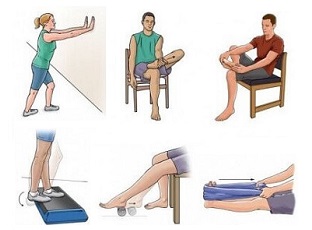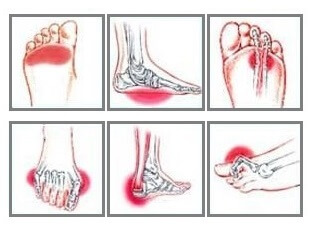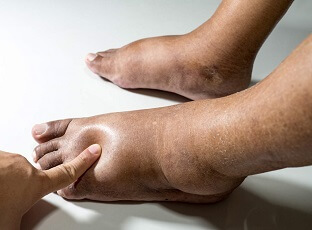- Home
- Common Foot Problems
- Foot Rashes
- Treatment
Foot & Ankle Rash Treatment
Written By: Chloe Wilson BSc(Hons) Physiotherapy
Reviewed By: FPE Medical Review Board
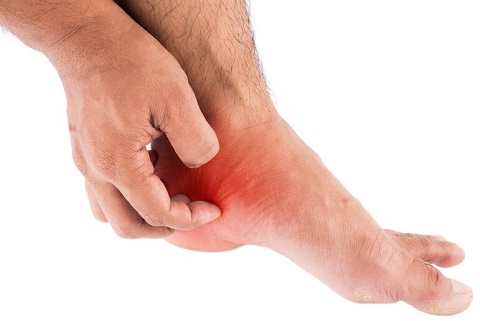
Foot and ankle rash treatment looks to reduce skin irritation, inflammation and itching.
Effective treatment for foot rashes will depend on the underlying cause and the severity of the rash.
The most common causes of a rash on the feet or ankles are contact dermatitis, eczema, infections and conditions such as psoriasis.
Here we will look at the best treatments for toe, foot and ankle rashes, how they work, what conditions they are most effective for and the possible side effects.
What Causes Ankle & Foot Rashes?
A foot or ankle rash is usually caused by either:
1. Allergic Reaction
The most common cause of a foot or ankle rash is an allergic reaction, known as Dermatitis. Foot rash dermatitis typically falls into three categories:
- Irritant Contact Dermatitis: Outer, protective layer of skin is damaged. Symptoms include non-itchy foot or ankle rash, dry, cracked skin. Caused by contact with chemicals e.g. cleaning products, cosmetics and detergents
- Allergic Contact Dermatitis: Immune reaction in skin when exposed to allergens. Symptoms include intense itchy foot rash, redness, small bumps, blisters. Caused by contact with allergens e.g. plants, latex, metals
- Eczema aka Atopic Dermatitis: Chronic condition triggered by but not caused by exposure to allergens. Symptoms include dry, red patches of inflamed skin which flare up periodically, often itchy at night. Multifactoral causes including ineffective skin barrier, bacteria, stress and anxiety.
2. Infection
The most common infection causing foot rashes is:
- Athletes Foot: Fungal infection from ringworm aka tinea pedis. Symptoms of athletes foot include a flaky, scaly, itchy, red rash between toes and on top of foot that may sting or burn. Caused by prolonged foot warmth and dampness.
3. Medical Conditions
Certain medical condition can result in a foot or ankle rash including Psoriasis, Lyme Disease, Hand, Foot & Mouth disease, Chicken Pox and Shingles.
RELATED ARTICLE: Common Causes of Ankle & Foot Rashes
Foot & Ankle Rash Treatment
Effective foot and ankle rash treatment will depend on the underlying cause of the foot or ankle rash and typically includes:
- Topical Corticosteroids: Contact Dermatitis, Fungal Infections & Eczema
- Anti-Histamines: Contact Dermatitis & Eczema
- Anti-Fungals: Fungal Infections
- Good Foot Hygiene: Contact Dermatitis & Fungal Infections
Let's have a look at how they each work, how to use them and the possible side effects.
1. Topical Corticosteroids
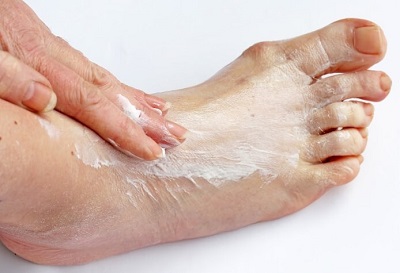
Topical corticosteroids are a popular choice of foot and ankle rash treatment.
Applied directly to the skin, topical corticosteroids reduce inflammation and irritation from allergic skin reactions, making the foot less red and itchy.
Topical corticosteroids are available in various different forms including:
- Corticosteroid Creams: most suitable for moist or weeping lesions and hairy areas. Most commonly used type of topical corticosteroid.
Pros: good lubrication, vanish quickly into skin.
Cons: less well absorbed, often contain preservatives which can lead to irritation - Corticosteroid Ointments: most suitable for dry, flaky skin or areas of thick skin e.g. soles of feet.
Pros: occlusive leading to better absorption and increased effectiveness
Cons: feel greasy and not suitable for intertriginous areas - where two skin areas touch or rub together e.g. between toes - Corticosteroid Lotions: most suitable for large or hairy areas including the scalp. Also good for use with allergic contact dermatitis e.g. Calamine works well with rashes from poison ivy/oak
- Corticosteroid Dressings: used for increased absorption often in combination with creams and ointments
Topical corticosteroids are available in a range of strengths or potencies depending on the severity of your foot or ankle rash:
- Mild: e.g. hydrocortisone
- Moderate: 2-25x as potent as hydrocortisone
- Potent: 100-150x as potent as hydrocortisone
- Very Potent: up to 600x as potent as hydrocortisone
They are not particularly imaginatively named classifications but they are easy to understand!
There is a huge range of corticosteroids suitable as part of foot and ankle rash treatment available at Amazon >
Mild topical corticosteroids are usually available over the counter from a pharmacist but anything stronger will require a prescription. You should always use the lowest potency corticosteroid that is effective for your foot or ankle rash.
It is important to be aware that topical corticosteroids will not cure the underlying problem and foot and ankle rash symptoms may flare-up when treatment is discontinued. However, they can provide excellent symptomatic relief of inflammation and itching and help control the problem, making them a very important part of foot and ankle rash treatment.
Topical Corticosteroids With Anti-Microbials
Topical corticosteroids may also contain another active ingredient, anti-microbials, for treating bacterial or fungal infections such as infected Eczema or Athlete’s Foot.
Anti-microbials are typically applied two to three times daily for a short period, usually 5-7 days, as part of the foot or ankle rash treatment. Longer-term use is not advised as it can lead to antimicrobial resistance.
Commonly Used Topical Corticosteroids
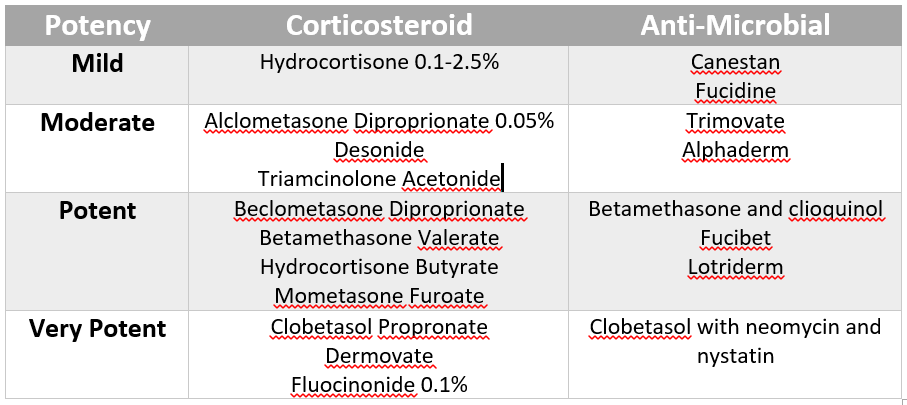
How To Apply Topical Corticosteroids
Most topical steroids only need to be used once or twice a day for foot or ankle rash treatment.
To apply topical corticosteroids effectively for foot or ankle rashes:
- Wash your hands thoroughly
- Squeeze the topical corticosteroid onto your index finger from the last finger crease to the finger tip – known as a finger tip unit (1 FTU)
- Apply to affected area of skin in downwards motion in direction of hair growth
- Do not rub the treatment in
- Wash your hands thoroughly
Guy’s and St Thomas’s NHS Trust in London, UK has produced a really helpful video on how to use topical corticosteroids.
It's definitely worth a watch! And there are loads of different topical corticosteroids available on Amazon >

How Much Do I Use?
Topical corticosteroid dosage is measured in Finger Tip Units "FTU", the distance from the last finger crease to the finger tip on your index finger.
- Adult Male: one fingertip unit provides approx. 0.5 g
- Adult Female: one fingertip unit provides approx. 0.4 g
when applied correctly 1 FTU covers approximately the same area as two hands laid flat with the fingers together, leaving a thin, glistening layer over the applied area. Thinner areas of skin such as eyelids will require less cream or ointment than thicker areas such as the soles of the feet.
Typical dosages when using topical corticosteroids for rashes are:
- One Hand, Elbow or Knee: 1 fingertip unit
- One Foot (including sole): 2 fingertip units
- Face and Neck (combined): apply 2.5 fingertip units
- One Arm (full length front and back): 3 fingertip units
- One Leg (full length front and back: 6 fingertip units
- Trunk (front & back): 14 fingertip units
- Entire Body: approx. 40 units
Child aged 4 years: should use approximately 1/3 of the adult amount
Infant 6 months to 1 year: should use approximately 1/4 of the adult amount
Side Effects Of Topical Corticosteroids
When used correctly, there are very few side effects from using topical corticosteroids for foot and ankle rash treatment. The most common side effect is a temporary stinging or burning sensation when applied, but that usually settles as your skin gets used to the treatment.
Side effects are more likely when using a more potent corticosteroid or with long term use (more than one to two months of continuous use) and typically affect young children and the elderly.
Side effects of topical corticosteroid used for foot rashes include:
- Skin thinning
- Enlarged blood vessels
- Easy bruising
- Mild lightening of the skin
- Localised hair thickening and length
- Folliculitis
- Stretch marks
2. Anti-Histamines For Foot Rashes
Oral anti-histamines are really helpful for treating itchy foot rashes and are usually available over the counter without a prescription.
Anti-histamines work particularly well for allergic contact dermatitis and eczema where the skin mistakes harmless substances such as pollen as potential harmful. The skin responds by producing histamine, an immune system protein.
Anti-histamines are a great way to reduce the itching and scratching cycle and when discomfort is interfering with daily life.
Types of Anti-Histamine
Oral anti-histamines fall in to two categories:
- First Generation Antihistamines: Affect the brain and increase drowsiness e.g. diphenhydramine
- Second Generation Antihistamines: Do not affect the brain and thus don’t cause drowsiness e.g. Cetirizine (Zyrtex) and Loratidine (Claritin)
First generation antihistamines are particularly useful if itching and discomfort is affecting your sleep, a common problem with eczema. Care should be taken though, particularly if you take them during the day due to their sedating affect.
There are a whole range of antihistamines that can be used for ankle rash treatment available on Amazon >
Side Effects of Anti-Histamines
Possible side-effects of anti-histamines for foot and ankle rashes include:
- Impaired ability to drive or operate machinery
- Impaired ability to concentrate and think clearly
- Dry mouth & eyes
- Headaches
- Abdominal Pain
3. Topical Anti-Fungals
Topical anti-fungals are used for foot and ankle rashes caused by fungal infections such as athletes foot. They either:
- Kill the fungus
- Prevent fungus growing
Anti-fungals are available in different forms for treating foot and ankle rashes, the most commonly used being creams, ointments or sprays. Your doctor may advise using both an anti-fungal to clear the infection and a mild corticosteroid to reduce the inflammation.
Anti-fungals for foot rashes can be bought over the counter and there are a huge range of options out there such as Lamisil, Daktarin & Sporanox. There are a whole range of antifungal medications that can be used for ankle rash treatment available on Amazon >
For those stubborn foot rashes, you may need prescription-strength foot medication from your doctor, typically recommended if:
- the infection hasn't improved after 4 weeks of treatment
- your foot rash keeps coming back
- the infection is spreading
Side Effects of Anti-Fungals
The side effects of topical anti-fungal foot and ankle rash treatments tend to be mild and include:
- Stinging or burning sensation
- Skin redness and/or inflammation
- Skin flaking
- Tenderness
4. Good Foot Hygiene
Good foot hygiene is also an important factor in foot and ankle rash treatment.
- Wash & Dry Feet Daily: taking particular care to dry in-between the toes
- Change Socks Daily: and opt for moisture-wicking socks if you tend to have sweaty feet
- Rotate Shoes: Alternate shoes each day to give them time to dry out completely
- Avoid Going Barefoot: especially in public places
- Trim Toenails: fortnightly
What Else Can Help?
There are some other simple things that you can try as part of your foot or ankle rash treatment:
- Cold Compress: helps to reduce pain and inflammation
- Moisturising Daily: choose a mild, unscented cream and avoid the areas between your toes e.g. E45
- Cool Oatmeal Foot Bath: using emolients such as Aveeno
- Avoid Triggers: such as pollen
For foot or ankle rash treatment to be effective, it is really important to know what is causing the foot rash so that you can treat it effectively so talk to your doctor.
You can find out loads more about the possible causes and how to tell the difference between them in the Foot Rash, Itchy Feet, Red Feet and Foot Lumps & Bumps sections.
Related Articles
References
- American Academy of Family Physicians. Choosing Topical Corticosteroids. JD Ference & A.R. Last. January 2009
- NHS UK: Topical Corticosteroids. January 2020
- British Medical Journal Clinical Evidence. Athlete's Foot. F. Crawford. 2009
Page Last Updated: 18th January, 2025
Next Review Due: 18th January, 2027
